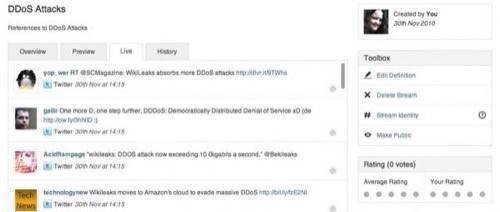When Twitter unveiled its own Tweet button back in August, Tweetmeme announced that it was shifting focus to a number of other products, including DataSift, a real-time analytics product. ReadWriteWeb received an alpha invite to DataShift today and has a sneak peak at what may become an indispensible tool for those who want to collect, map, or research data gathered from the social web.

As this is an alpha release, DataSift is likely to see a number of changes before launch. But some of the key features are in place already, including its FSDL, Filtered Stream Definition Language. This is the programming language that runs the filtering engine for DataSift. With FSDL you can compose quite complex rules defining which sort of information you’d like to track. You can, for example, filter based on content, Twitter username, number of Twitter followers, profile information, sentiment, and/or Tweet location.
One of the interesting features of DataSift’s FSDL is the ability to build new “super rules” based on existing ones. You’ll also be able to share your rules so that others can build on your work. Another great benefit of this tool is that it searches beyond Twitter and includes MySpace, WordPress, and Six Apart as sources.
I created a DataSift stream today to look for information about “DDoS attacks,” a stream that was fairly easy to put together with the quick reference guide. I was struck how quickly the information was available for me to review (thank you WebSockets). I also quickly realized that I had to refine my search so I wasn’t pulling all the tweets on “kiddos” and the like. But I can certainly see this tool being a good one to have in our arsenal. Um, DataSift that is. Not denial of service attacks. Clearly.

DataSift also has an API that will allow third-party developers to consume the filtered data, and DataSift plans to have an App Store to help encourage people to build tools with the platform.
Although Twitter has indicated it will launch its own real-time analytics dashboard, that feature has yet to make an appearance. And as Marshall Kirkpatrick noted with his story on Needlebase earlier today, there are a number of interesting analytics tools being released in the meantime.

















